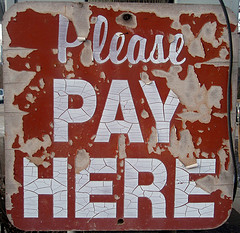It’s beginning to look like the summer of 2009 (or Fall of 2009, depending on how slowly these projects move forward) may be the season in which paid content on major news publishers returns to favor.
Returns to favor among publishers, that is. Will readers accept new paywalls, or simply go elsewhere? Will micropayments finally become a cost-effective option users adopt, or just a costly distraction? What about freemium models, in which base content remains free but other rewards are used to entice what amount to donations?

According to Editor & Publisher (reporting based on an aritcle in Financial Times, which ironically you may or may not be able to read depending on your rank in FT’s metered access system), the Wall Street Journal plans to begin testing the micropayments approach this fall:
They call it “a milestone in the news industry’s race” to find better online business models.
“A sophisticated micro-payments service” will launch this autumn, Robert Thomson, editor-in-chief of Dow Jones and managing editor of the Journal, told the Financial Times.
What kind of pricing will the micro-payments support? Financial Times reported:
Pricing for individual articles and for premium subscriptions had yet to be decided, [Thomson] said, but would be “rightfully high”.
Wouldn’t that make them not micro-payments? Not exactly macro-payments, which might be a good term for the $100+ regular Wall Street Journal subscription, but just plain old payments?

Meanwhile, at the New York Times, Valleywag reports based on the Twitter streams of two attendees to a strategy meeting that the model will not be micropayments:
Apparently the NYT does not want to have its standard content be paid per se, because they feel that it would hurt online ad revenue too much. The paid online plan that’s being floated sounds instead like some sort of backdoor way to get revenue out of those readers who love the NYT so much that they’d be happy to donate money to it. So—and all of this is still in the planning stages, it seems—the idea would be to keep access to the current content free, then devise some sort of program offering superlatives or rewards to people who want to pay to be “members.” Keep ad revenue high and add additional revenue streams, rather than gate content and risk seeing traffic plummet.
Yes, the irony of citing a Gawker media article, which is itself based on twitter streams, in a piece about the future of the New York Times is not lost on me. I love twitter as much as everyone else (see @jeckman) but it does feel strangely postmodern to try to divine the strategy of the Old Gray Lady from a tweet like this one:
What wud premium members want? Free stuff and discounts? Access to ppl? Trying to fig that out.
That said, the transparency that Twitter provided in this case is an interesting improvement over the carefully edited, on-message press release that must eventually result from the brainstorming in that room.
My own twitter response?:
@michaelluo Want: more access to ppl. More good content. Do not want: macro-payments or micro-payments. kthxbai #nytimes #premium
(Update: See more info about the WSJ’s plans on paidcontent.org and Jeff Jarvis’ response: Bring it On, Rupert which outlines what Jarvis feels are the negative results likely to occur)